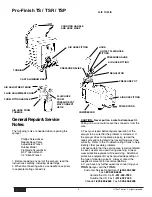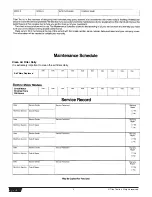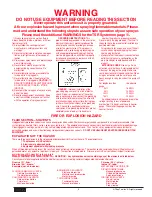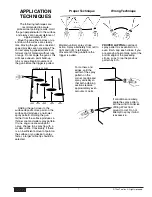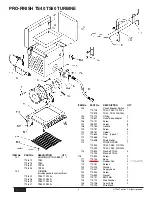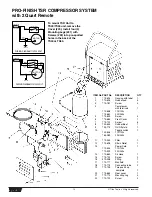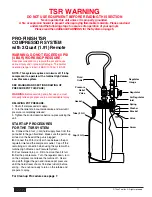
5
© Titan Tool Inc. All rights reserved.
1) Always keep spray area well ventilated.
Always keep the turbine a minimum of 20 feet
from spray activity.
2) Always follow the coating or solvent
manufacturer’s safety precautions and
warnings.
3) Never spray flammable materials near open
flames, pilot lights or any other source of
ignition.
4) Always wear spray masks and protective eye
wear while spraying.
5) Never alter or modify any part of this
equipment; doing so could cause it to
malfunction.
6) Never attempt to service or assemble the
turbine while it is plugged in.
7) Never attempt to clean the exterior of the
turbine while it is plugged in. CAUTION: TO
REDUCE THE RISK OF ELECTRIC SHOCK,
DO NOT EXPOSE TO RAIN – STORE
INDOORS
8) Never point the spray gun at anyone or any
part of the body.
9) Never leave equipment unattended. Keep
away from children or anyone not familiar
with the operation of spray equipment.
GROUNDING INSTRUCTIONS: This
product should be grounded. In the event of an
electrical short circuit, grounding reduces the
risk of electric shock by providing an escape
wire for the electric current. This product is
equipped with a cord having a grounding wire
with an appropriate grounding plug.The plug
must be plugged into an outlet that is properly
installed and grounded in accordance with all
local codes and ordinances.
DANGER - Improper installation of the
grounding plug can result in a risk of electric
shock. If repair or replacement of the cord or
plug is necessary, do not connect the grounding
wire to either flat blade terminal. The wire with
insulation having an outer surface that is green
(with or without yellow stripes) is the grounding
wire. Check with a qualified electrician or
serviceman if the grounding instructions are not
completely understood, or if in doubt as to
whether the product is properly grounded.
Do not modify the plug provided; if it will not fit
the outlet, have the proper outlet installed by a
qualified electrician.
• This product is for use on a nominal 120-volt
circuit and has a grounding plug that looks
like the plug illustrated.
• Make sure that the product is connected to an
outlet having the same configuration as the
plug. No adapter should be used with this
product.
EXTENSION CORDS: Use only a 3-wire
extension cord that has a 3-slot receptacle that
will accept the plug on the pump. Make sure
your extension cord is in good condition. When
using an extension cord, be sure to use one
heavy enough to carry the current this pump will
draw.
For lengths less than
Use extensio
gauge
25 ft.
16 AWG
50 ft.
14 AWG
100 ft.
12 AWG
150 ft.
10 AWG
An undersized cord will cause a drop in line
voltage resulting in loss of power and
overheating. If in doubt, use the next heavier
gauge. The smaller the gauge number, the
heavier the cord.
FIRE OR EXPLOSION HAZARD
FLUID SECTION—SOLVENTS
Halogenated Hydrocarbon solvents can cause an explosion when used with aluminum or galvanized components in a closed (pressurizable ) fluid
system (pumps, heaters, filters, valves, spray guns, tanks, etc.). The explosion could cause serious injury, death and/or substantial property damage.
Cleaning agents, coatings, paints, etc. may contain Halogenated Hydrocarbon solvents. Titan Tool Inc. spray equipment includes aluminum or
galvanized components and will be affected by Halogenated Hydrocarbon solvents. DO NOT USE HALOGENATED HYDROCARBONS IN TITAN
EQUIPMENT.
EXPLANATION OF THE HAZARD
There are three key elements to the Halogenated Hydrocarbon (HHC) solvent hazard. These elements are:
1. The presence of HHC solvents.
2. Aluminum or galvanized parts.
3. Equipment capable of withstanding pressure.
When all three elements are present, the result can be an extremely violent explosion. The reaction can be sustained with very little aluminum or
galvanized metal: any amount of aluminum is too much. The reaction is unpredictable. Prior use of an HHC solvent without incident (corrosion or
explosion) does NOT mean that such use is safe.
HALOGENATED SOLVENTS –
DEFINITION : Any hydrocarbon solvent containing any of the elements as listed below:
Consult your material supplier to determine whether your solvent or coating contains Halogenated Hydrocarbon Solvents.
Fluorine (F) “-fluor-”
Bromine (Br) “-bromo-”
Examples (not all-inclusive):
FLUOROCARBON SOLVENTS:
Dichlorofluoromethane
Trichlorofluoromethane
CHLORINATED SOLVENTS:
Carbon tetrachloride
Chloroform
Ethylene dichloride
BROMINATED SOLVENTS:
Ethylene dibromide
Methylene chlorobromide
Methyl bromine
TRICHLOROETHANE:
Trichloroethylene
Monochlorotoluene
Chlorine (CL) “-chloro-”
Iodine (I) “-Iodo-”
METHYLENE CHLORIDE OR
DICHLOROMOETHANE:
Monochlorobenzene
Orthodichlorobenzene
Perchloroethylene
IODINATED SOLVENTS:
N-butyl iodide
Methyl iodide
Ethyl iodide
Propyl iodide
WARNING
DO NOT USE EQUIPMENT BEFORE READING THIS SECTION
Never operate this unit unless it is properly grounded.
A fire or explosion hazard is present when spraying flammable materials. Please
read and understand the following steps to assure safe operation of your sprayer.
Please read the additional WARNINGS for the TSR System on page 11
.



